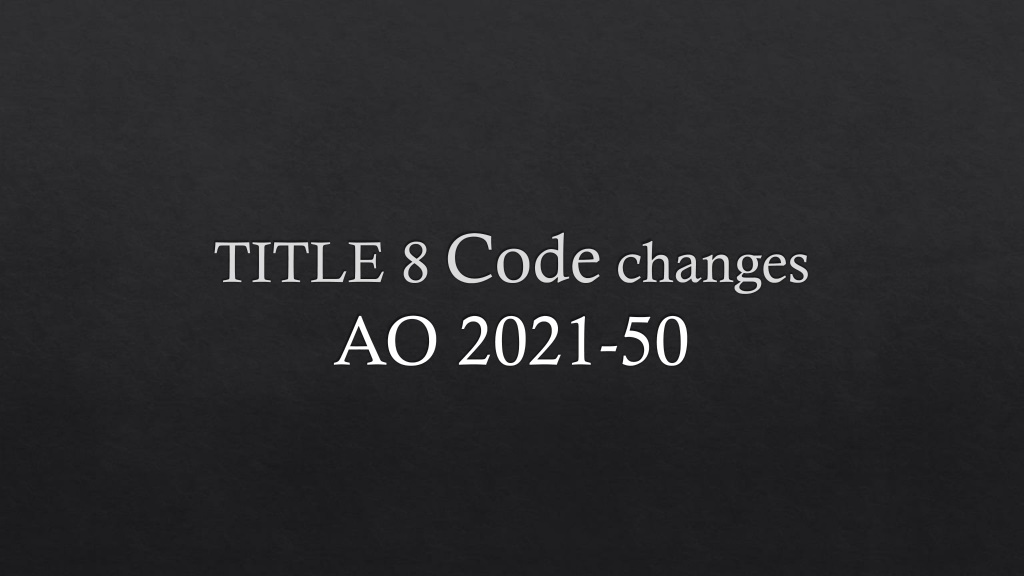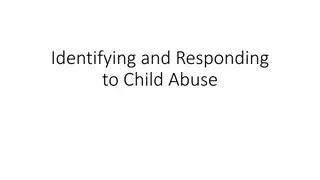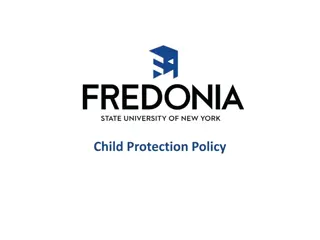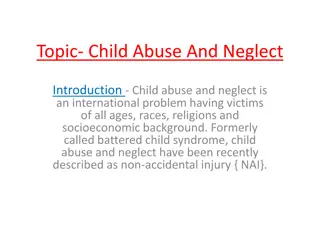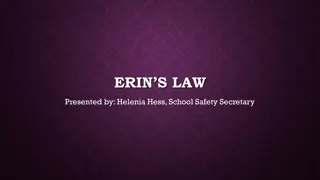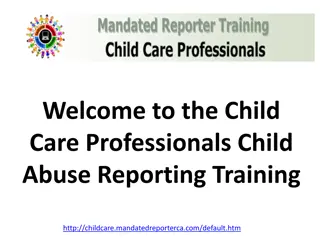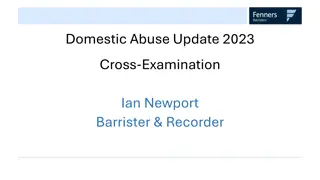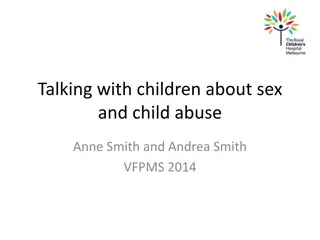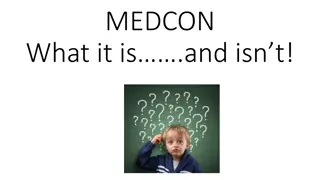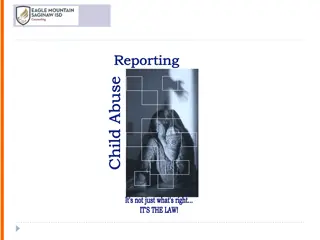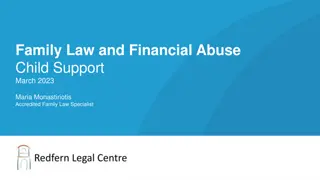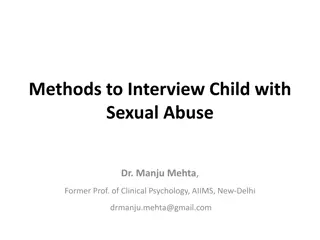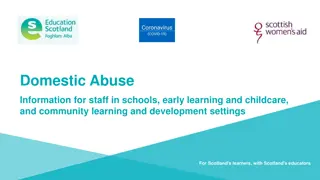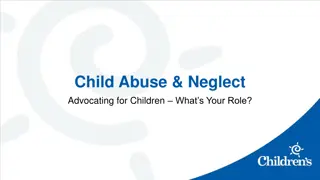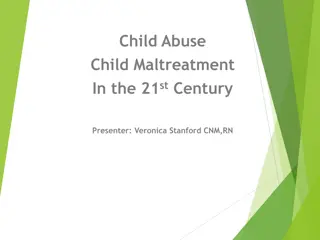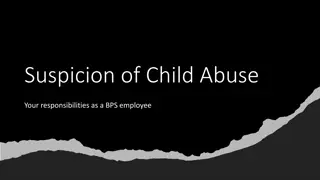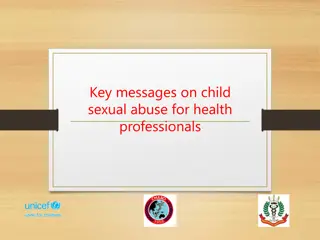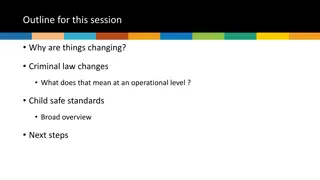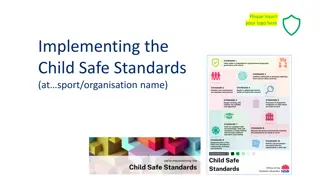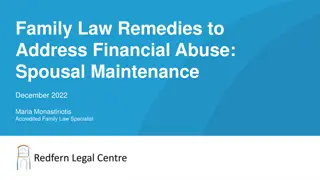Changes in Child Abuse Law: AO 2021-50
This document outlines significant changes in the Title 8 code relating to the abuse of children and vulnerable adults under AO 2021-50. The amendments clarify the levels of intent required for causing or permitting physical injury, decriminalize negligence in permitting child injury, and delete sections related to reasonable parental discipline. Additionally, it eliminates actions deemed prima facie unreasonable in cases of child abuse. These modifications aim to provide clarity and ensure appropriate treatment of child abuse cases.
Download Presentation

Please find below an Image/Link to download the presentation.
The content on the website is provided AS IS for your information and personal use only. It may not be sold, licensed, or shared on other websites without obtaining consent from the author. Download presentation by click this link. If you encounter any issues during the download, it is possible that the publisher has removed the file from their server.
E N D
Presentation Transcript
TITLE 8 Code changes AO 2021-50
8.10.030(B) Abuse of a Child or Vulnerable Adult Changes level of intent for causing or permitting physical injury from intentional, knowing, reckless or negligent to reckless. B. vulnerable adult if the person recklessly causes or permits a child or a vulnerable adult to be physically injured, or negligently causes or permits a child or vulnerable adult to be tortured, cruelly confined, or cruelly punished. A person commits child abuse or abuse of a This does two things. 1. Decriminalizes negligently permitting injury to a child. 2. Clarifies that to be found guilty, a defendant need only be found to have acted with reckless disregard for possibility of injury. [A PERSON COMMITS CHILD ABUSE OR ABUSE OF A VULNERABLE ADULT IF THE PERSON INTENTIONALLY, KNOWINGLY, RECKLESSLY, OR NEGLIGENTLY CAUSES OR PERMITS A CHILD OR VULNERABLE ADULT TO BE TORTURED; CRUELLY CONFINED; CRUELLY PUNISHED OR PHYSICALLY INJURED.] Clarifies that the level of intent for finding someone guilty of torture, cruel confinement, or cruel punishment, is negligence. In other words, the requisite level of intent is lower for torture than for allowing simple injury.
8.10.030(D) and (E) These sections are deleted. This does two things: [D. SUBSECTION "REASONABLE PARENTAL DISCIPLINE." IT IS AN AFFIRMATIVE DEFENSE TO ABUSE OF A CHILD IN B. THAT THE ACTION WAS TAKEN AS Deletes a confusing set of factors which combine subjective and objective analysis of reasonableness. E. FOR PROMOTING THE CHILD'S MORAL, SOCIAL, OR CULTURAL WELFARE. FACTORS TO BE CONSIDERED IN DETERMINING WHETHER THE ACTION CONSTITUTED REASONABLE PARENTAL DISCIPLINE ARE: REASONABLE PARENTAL DISCIPLINE IS ACTION TAKEN THE PURPOSE OF SAFEGUARDING THE CHILD OR Resolves concerns voiced by Court of Appeals that the affirmative defense might be unconstitutional NOTE: A necessity defense already exists in state code which justifies injuring a child to further the welfare of the child. 1. AGE OF THE CHILD; 2. CONDITION OF THE CHILD; 3. TYPE OF MISCONDUCT; 4. KIND OF PUNISHMENT INFLICTED; 5. DEGREE OF HARM OR PAIN TO THE CHILD; 6. OPTIONS THAT EXISTED; 7. APPARENT MOTIVE OF THE PARENT; AND 8. CULTURAL PERSPECTIVE OF THE PARTIES.
8.10.030(F) This section is deleted in its entirety. F. ACTIONS WHICH ARE PRIMA FACIE UNREASONABLE ARE: 1. SCALDING, BRANDING, OR BURNING OF A CHILD; First, by using the term prima facie this subsections tells jurors that conduct listed here can be found to be reasonable. For example, branding a child can be found to be reasonable according to this list. (Again, nothing prevents defendants from using the necessity defense found in state code if appropriate.) 2. SHOULD HAVE REQUIRED MEDICAL TREATMENT; INJURIES THAT REQUIRE OR REASONABLY 3. MEAL; WITHHOLDING OF FOOD FOR MORE THAN ONE By providing jurors with a list, the subsection signals to jurors that any conduct not on this list can be assumed to be reasonable. This makes it harder to prosecute conduct not foreseen by the authors of this code. 4. INJURIES LOCATED ON MULTIPLE BODY SITES; 5. PERMANENT HARM; CONDUCT LIKELY TO CAUSE SERIOUS OR Again, the Court of Appeals found this section to be problematic. 6. DISPROPORTIONATE; CONDUCT THAT IS SIGNIFICANTLY 7. PUNISH; CONDUCT DESIGNED TO TORTURE OR CRUELLY 8. INJURIES TO FACE OR HEAD; AND 9. SHAKING A CHILD UNDER FIVE YEARS OF AGE.
8.10.110(A) Harassment It is unlawful for any person, with reckless disregard for any harassing or annoying effect on [INTENT TO HARASS OR ANNOY] another person, to: This lowers the level of intent from intentional to reckless. It also changes the crime from intending to harass or annoy to disregarding a harassing effect on a victim. Currently a defendant can simply argue that they are not guilty because they didn t intend to harass. For example, I thought she d like it.
8.10.110(A)(2) 2. or distribute, or threaten to publish or distribute, electronic or printed photographs, pictures, images, videos, or films that show the genitals, anus, or female breast of the other person or show that person engaged in a sexual act; Except as provided in chapter 8.50, publish This subsection criminalizes threatening to distribute pornographic images, a fact pattern we frequently see when abusive defendants attempt to control their victims/witnesses. This subsection also adds images and videos to the list of materials disallowed for distribution. This is primarily an acknowledgement of current technology. It also criminalizes altered photos of a harassing nature.
8.10.110(A)(4) 4. offensive physical contact and the unwanted or offensive physical contact is touching directly or through the clothing another person s genitals, buttocks, or female breast; or Subject another person to unwanted or Asking jurors to first determine whether sexual misconduct is offensive can cause confusion and distract jurors. Each juror might have a different definition of what is offensive. The important point is that the behavior is unwanted sexual contact. This criminalizes direct contact with genitals, buttocks, or the female breast.
8.10.110(B) B. Violation of subsections A.1. or [THROUGH] A.3. is a class B misdemeanor. Violation of subsection A.2., A.4. or A.5. is a class A misdemeanor. Violation of 8.10.110(A)(2) would now be a Class A Misdemeanor. Publishing sexual pictures of another person should be prosecuted at the same level as we prosecute unwanted sexual contact or subjecting another to bodily fluids. Publishing these images is far more serious behavior than taunting or challenging language (A)(1) or touching another in an offensive manner (A)(2).
8.20.010(A)(1) and (A)(7) Criminal Mischief 8.20.010 - Criminal mischief. This changes the level of intent from intentional to knowing as to conduct and reckless as to result. A. right to do so or any reasonable ground to believe the person has such a right, to It is unlawful for any person, having no This knowing/reckless standard is already codified in AMC 8.05.010(B) and is the default level of intent when a specific level is not specified in the code. 1. amount of $50.00 or more [WITH INTENT TO DO SO]; or 7. Damage property of another in an amount of less INTENT TO DO SO]; or Damage property of another in an Frequently in DV situations the intent might not be to cause damage to property, but rather to exert influence and control. than $50 [WITH
